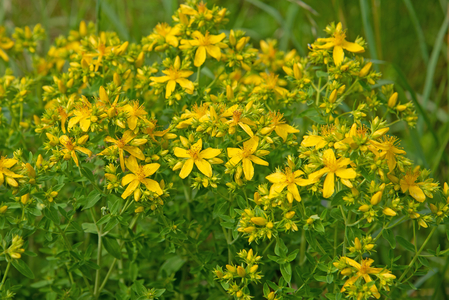Utilisation

Early on, St John's wort was prescribed by wound doctors for injuries and wounds. In the 16th century, Paracelsus documented an antidepressant effect, but he used the herb to treat "phantasma", which was more akin to driving away demons. In Austrian folk medicine, St John's wort is known as the 'arnica of the nerves'.
Today, the tips of the shoots, which are harvested during the flowering period and then dried, are used as the raw material for medicines.
Medicines containing special industrially produced dry extracts of Hypericum are authorised for the treatment of mild to moderate depression. Multiple medications can interact with different drugs, which is why treatment with St John's wort should always be supervised by a doctor.
Red St John's wort oil is produced by infusing the fresh flowers in vegetable oil. Traditionally, the preparation is exposed to sunlight for 2-3 weeks, which results in the transformation of the ingredients and the deep red colour. St John's wort oil is traditionally used to promote wound healing and for mild skin inflammation.
Important ingredients are the red naphthodianthrones (hypericin, pseudohypericin), phloroglucin derivatives (including hyperforin), tannins and flavonoids.
Botany
St John's wort, from the St John's wort family(Hypericaceae), is a perennial plant up to 60 cm tall with striking golden-yellow inflorescences.
The individual flowers are radially symmetrical (radiate; the flower can be divided into two equal halves by at least three levels of symmetry) and five-petalled. The numerous stamens (male part of the flower) are arranged in three or five bundles around the three female pistils.
The stem of St John's wort is erect, bipartite (round stem with two opposite longitudinal ridges), pithy and opposite-leaved.
The ovate to oblong leaves are covered all over with translucent oil glands and some with black glands.
Distribution
Around 420 species of St John's wort are known worldwide, 56 of which are native to Europe and 13 to Austria.
The herb is found in Europe, western Asia, the Canary Islands and North Africa and prefers to grow in sparse locations such as rough pastures, embankments, roadsides and forest edges. As a pioneer plant, it can also be found on fallow land, rubble heaps or railway ballast. In Austria, it is very common from colline (in the plains and hills) to montane in all federal states.
St John's wort is pollinated by pollen-seeking insects such as bees, bumblebees and hoverflies. The capsule fruit opens in dry conditions and the seeds are carried by animals or spread by the wind.
Due to its undemanding nature, St John's wort is easy to care for and can easily be grown in your own garden. The plant is hardy and perennial and requires little fertiliser and water. It prefers a sunny, sandy, calcareous, nutrient-poor location. It flowers from June to August and the seeds can be harvested until October. Direct sowing outdoors is easiest. As it is a light germinator, the seeds should only be thinly covered with soil and should not be kept too moist.
Service
The preservation of diversity is very important to us, which is why we store around 5,400 samples of seeds and plants in our gene bank . With the gene bank for agricultural crops, medicinal and aromatic plants, we are making a significant contribution to the preservation of biodiversity.
Last updated: 12.07.2024
automatically translated